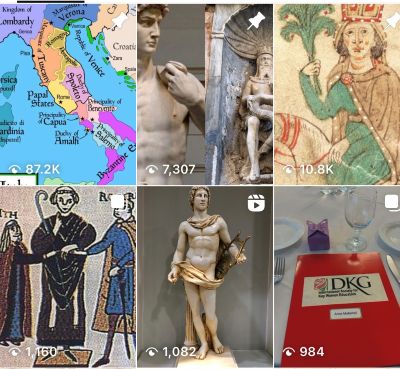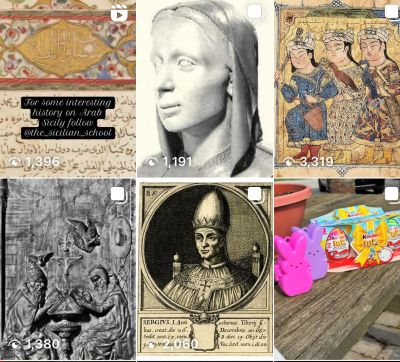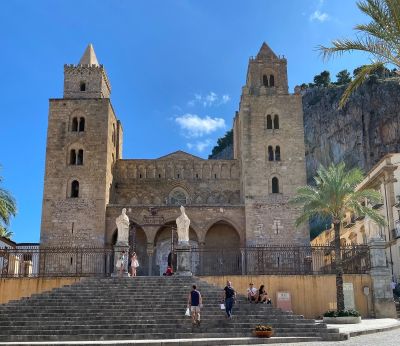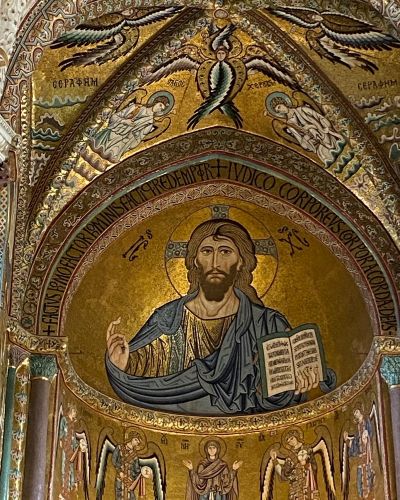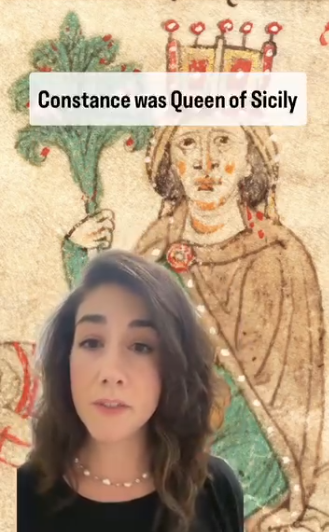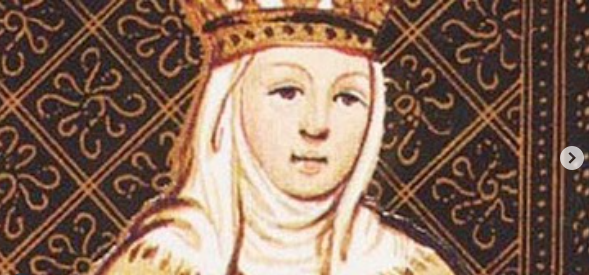
The narrative surrounding Renaissance Italy has long been centered in the north, thanks to the influence of the Medici family, Dante, Leonardo da Vinci, Michelangelo, Raphael, and Botticelli. Culturally rich Southern Italy and Sicily, however, have been left out of the conversation, and for far too long, argues Anne Maltempi, an assistant professor of history at the University of Mount Union and founder of Instagram's @The_Sicilian_School. Through her teachings in the classroom and via social media reels, she invites students to appreciate the ways Renaissance Sicily stands apart, shaped by its Greek, Arab, Norman, and Spanish influences on the arts, sciences, and humanities.
Sicily is a strong part of Dr. Maltempi's identity as a daughter of Sicilian immigrants from Oliveri, within the Province of Messina. She grew up speaking Sicilian thanks to her closeness with her paternal grandparents, who had moved to the United States, and her maternal grandparents, with whom she often spent summers. But as she shared with me, it wasn't initially part of her planned career path.
We discussed how the stars ultimately aligned, how and why she has embraced social media, her favorite chapters and heroes from Sicilian history, why Sicily has been overlooked, her latest project, and where she hopes to shed light.
What inspired your career path?
When I started graduate school, I wanted to study English literature because I was a big Shakespeare fan. So, my first master's degree is in Shakespearean literature.
I realized that through that program, I was called more to history. As a scholar, I liked the historical aspects of Shakespeare's world almost more than I liked the literature itself, so I decided to pursue history.
Since I was studying Shakespeare, the next logical step seemed to be to study Tudor-Stuart Britain and see what the kings and queens were doing.
That field was saturated, and I was struggling to be inspired. So I said, "I know about the Renaissance, but I never hear anything about Sicily in the Renaissance. I'm Sicilian, and I wonder what was going on."
I found that nobody studies 15th and 16th-century Sicily much. There's a lot of stuff about the Middle Ages and later in the modern period. So, I would say I was led to that partly because of how I grew up, having been to Sicily so many times and not really understanding its history or becoming familiar with it other than my own family history and linguistic ability.
I grew up speaking Sicilian and later acquired Italian. That was a big bonus because it allowed me to further research that field. Sicilian scholars during the Renaissance did not speak Tuscan, like Dante in the Middle Ages; they spoke their own vernacular—a version of Sicilian. Picking up a 16th-century Sicilian document was really cool. Having language as a tool has been the bedrock that allowed me to continue on this career path.
Tell us about the Sicilian School you've created on social media.
I started the Sicilian School last July. I had been thinking about starting a social media page for a couple of years, partly because the job market for academics is not very great. I thought this would be an opportunity to teach my passion. I figured I may not have a classroom in the university, but maybe I can get one online and just build it myself.
I talked to my husband, and he said, "Look, you really love your work. Why don't you stop talking about a social media page and just do it? Maybe that'll be a good creative outlet for you."
So I did my first reel at some point last July, which was a comparison of Michelangelo's David to the genius of Palermo. I was expecting to get, I don't know, five views. I wasn't going into this with high hopes. Overnight, I got 500 views, and a bunch of people were commenting pretty positively. And that was all really validating.
My husband was right. It did become a really fun, creative outlet for me because then I got to think about other reels I wanted to do and series I wanted to start, and it just kind of snowballed from there.
Which chapter of Sicilian history fascinates you most and why
I will say my period, the 15th and 16th centuries, though it's really a toss-up. The history of the Middle Ages is great, too, because it's multicultural. There are pockets of Greek speakers, Arab speakers, and Jewish communities; of course, you have the Normans and the monarchs. You constantly have people coming in and out, so it's really interesting from that aspect.
The Middle Ages period is also fascinating from a political and governance aspect because Roger II and Frederick II proposed progressive documents from our perspective. They had constitutional-style documents, and they were administratively trying to make a cohesive connection within their kingdoms.
We mistakenly think that women didn't have much power in that system, but the power that they actually had is pretty impressive. So, I love the Middle Ages from that perspective.
I also love my period, because I think it really serves as the other half of the narrative of the Renaissance. After all, there are still a lot of writers, artists, and culturally elevated people in society. But the process is developing in a slightly different way because Sicily's not a city-state like Florence. It's actually part of the Habsburg Empire in my period. And there's some influence from Spain. It is decidedly less multicultural in that period because the Spanish essentially kicked out everybody who was not Catholic or forced them to convert.
But what I like politically about my period is that you see the contention between the noble Sicilians and Imperial Spanish representatives. I like looking at that because for so many years in modern history, the idea that's put forward is that Sicilians were this economically destitute, not very well educated, kind of people who were doomed to failure. When you look at the exchange between
these political figures, you see that Sicilians had a lot more power and agency than we tend to think of in that period.
We tend to think Florence was the big center of Renaissance culture, and that's why it's important and why we study it. But the truth is, the Renaissance was a big movement happening in different ways in different places, and Sicily offers one of those new perspectives into how Renaissance culture and thought developed in that period, which is not necessarily so centered on Florence.
The Cathedral of Cefalù in Sicily is a renowned example of the Norman-Arab-Byzantine architectural style.
Why has Sicilian history been overlooked?
That's the million-dollar question right there. And there are a lot of reasons. To start, linguistically, it's hard. Because you're going to the ancient period, where you can actively find documents in Latin, Greek, and Arabic, and in the Middle Ages, you're getting into early types of Italian vernacular, but really more so, early types of Sicilian vernacular.
I grew up speaking Sicilian dialect, but I grew up speaking a form of Sicilian dialect from the forties and fifties when my grandparents came. When I opened a 16th-century Sicilian book for the first time, I was like, "What am I looking at here? It's like a modern English speaker reading Shakespeare for the first time or reading Chaucer for the first time.
So linguistically, it's a complicated area of the world. It's also a complicated area of the world simply because of its history. It's one of the most dominated islands in human history. So you're going in relatively quick succession from the Greeks to the Romans, to the Arabs, to the Normans, to the Spanish. I mean, a bunch of people are there, and this is not to mention little groups like the Phoenicians, the Carthaginians, Vandals, Berbers, and everybody else showing up there. So that's complicated.
I also think there are historiographic tendencies. Scholars of history, especially in the 18th and 19th centuries, paid a lot of attention to Western Europe. And by Western Europe, I really mean North-Central Western Europe, places that were culturally mixed because of these proposed difficulties that I outlined previously, get ignored.
Sicily, particularly in the scope of Italian history, is one of the only areas in Italy that was under Arabic rule for a significant amount of time. And I do think there is a racial aspect to it. A certain marginalization comes with studying the history of a place that may be considered uncivilized.
I also think the Reformation played its part because there was a lot of Reformation propaganda against very Catholic spaces, particularly Spanish Catholic spaces, and Sicily was a Spanish territory. Sicily became this place where it's hard to study, while having some topics that may be a bit controversial to study. So, for those reasons, I think Sicily gets marginalized.
View within the Cathedral of Cefalù
You are writing a book. What can you tell us about it?
It's a work in progress. It is a historical text based on my dissertation. I'm basically looking at the work of five Sicilian intellectuals who were alive in the 15th and 16th centuries. I am reading their works and analyzing them to see how they defined themselves as Sicilian. Do they see themselves as Sicilian, or do they see themselves as Spanish because they're part of the Spanish Empire? Or do they still see themselves as descendants of Normans, Romans, or Greeks? How do they define themselves?
I think the process of identity formation highlights a lot of those missing spots in history that can be filled because you have to look at how they conceptualize their own history and what they feel is artistic and culturally viable, including island culture. How do they feel about living on an island? Do they define themselves by the fact that they're living on an island?
All of those things go into it. So, that's what my book is about. Each chapter is going to be a different intellectual with their work, analyzing it specifically for those purposes, looking at whether they see themselves as Sicilian. And what, if so, did being Sicilian mean in the 15th and 16th centuries?
Queen Constance, the mother of Frederick II, is a favorite.
You've featured several women who stand out in Sicilian history. Who do you particularly admire?
There are two that I really love, and one might be glaringly obvious. I love Queen Constance. I think I have four or five reels on her. She's the mother of Frederick II, and she is one of the baddest ass women, I think, in medieval history. I just love her. I don't know if half the stories about her are true. I hope to God that they are, I mean, maybe it'd be nice if she weren't an assassin and killed her husband. I don't know if she actually did. I'm pretty sure that's just a conspiracy theory.
I think the coolest thing about her, aside from the story that she had a baby at 40 in the middle of a town square, is that she was Sicilian. She loved Sicily and retained rulership of Sicily even after marrying the Holy Roman Emperor.
Now granted, her husband didn't really care so much about ruling Sicily. He just wanted the benefits of being married to the Queen of Sicily. But who cares about that? She said, "I'm going to make the laws here, and you just sign off on them." And that's what happened.
It also kept her constituents happy because the Holy Roman Emperor had created some contention by marrying her. A lot of people in Sicily were concerned that they would lose their rights to the Holy Roman Empire. Her maintaining rulership of Sicily actually quelled quite a few rebellions because they said, "OK, so our queen is still our queen, and she's still going to do stuff for us." And that made a big difference.
She knew she wasn't stupid, and he knew that, too. He wasn't stupid either. It was also politically beneficial for him, but I still think that's pretty cool.
Adelaide del Vasto, mother of Roger II
One of the other women I really like is Adelaide del Vasto. She was the mother of Roger II. And we don't know as much about her as Constance because she was illiterate. So, the sources we have from her are dictated. But she was a Lombard, originally the Lombard Princess, but really fell in love with Sicily and ended up staying there the last few years of her life. She actually left most of her wealth to a monastery in Sicily, where she ended up spending her last few years.
I'd like to learn a little bit more about her. I feel like there's something more there that I just haven't been able to find yet. So that's kind of my secondary project. After I finish my first book, I want to look more into her. She's just really intriguing and fascinating to me. So I'm going to see what I can find.
What do you hope to share with your students and audience?
Minimally, I hope they enjoy what they're seeing, and through my work, recognize that there are a lot of places in the world and that all of those places have a culture, a significant contribution to make to broader society.
I want them to see that different people had different things to say, that all of those things are important, and that they provide something relevant to the world we live in now.
If you enjoyed this article, consider subscribing to my newsletter for more content and updates!
